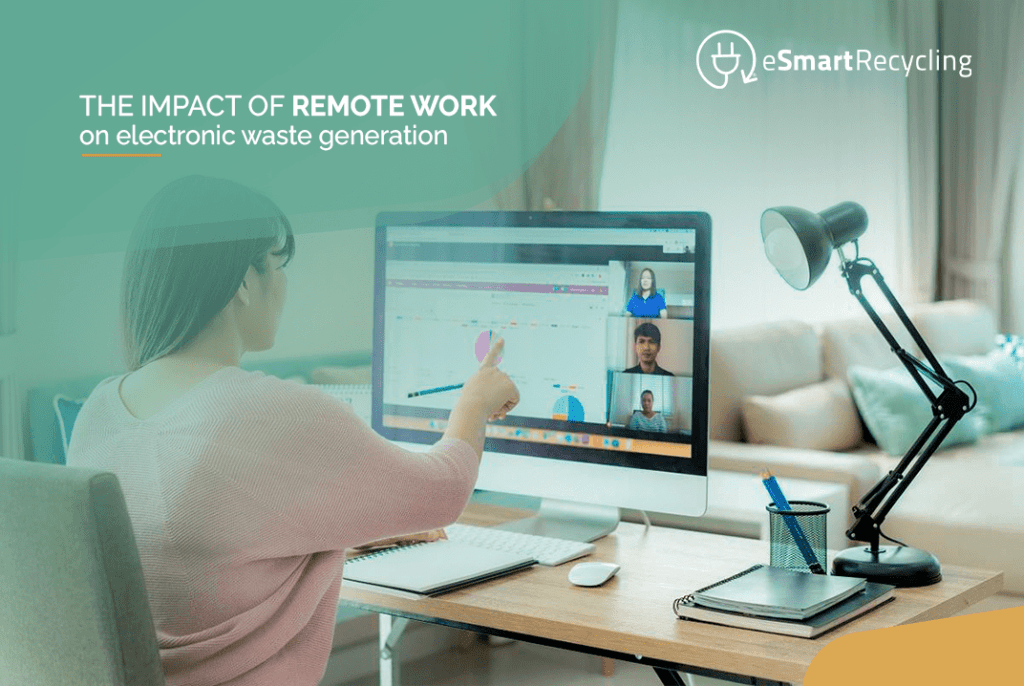
In our globalized society, technology has drastically transformed how we interact with each other and the physical world. However, as more companies have adopted remote work policies, the issue of electronic waste (e-waste) has gained increased importance. This article explores the impact of remote work on e-waste generation, the underlying causes, and possible solutions.
Remote work refers to working from a location other than a physical office. These remote work models can range from occasional work-from-home arrangements to fully remote teams operating from different geographic locations. The advent of the internet and cloud-based services has revolutionized how people can run businesses from their homes. Technological advancements in recent years have enabled a smooth transition to remote work, providing the tools and resources necessary for people to work effectively outside the traditional office environment.
Electronic waste refers to the improper disposal and management of electrical and electronic devices. These devices can include laptops, desktop computers, mobile phones, printers, and other gadgets. E-waste can contain hazardous materials like lead, cadmium, and mercury, which can lead to air and water pollution and pose potential health risks. Besides these environmental implications, improper e-waste management can result in significant economic losses for countries or localities unprepared to handle their discarded electronic devices.
With the increased use of technology, the amount of e-waste generated has also risen. The widespread adoption of remote work is a significant driver of e-waste generation. As more companies implement remote work policies, employees frequently connect to their networks from various locations, which can accelerate the rate at which devices become obsolete. Additionally, studies have shown that remote work can generate higher levels of e-waste than traditional office environments.
In today’s digital society, efforts must be made to address the challenges posed by the proliferation of electronic devices and the increased pace at which they become obsolete. One approach to limiting the amount of hazardous e-waste is promoting electronic recycling, the practice of recycling electronic devices. Industry experts widely agree that electronic recycling is an effective tool for managing the risks associated with e-waste. However, more than promoting these methods is required.
Some companies are now implementing strategies to reduce the environmental impact of e-waste generation. Some well-known companies have adopted policies that define the responsible disposal of electronic devices. For example, Microsoft has launched programs that recover and reuse materials from their electronic devices. By doing so, the company can reduce its environmental impact and create local jobs to dismantle old devices and retrieve and/or recycle valuable materials.
Additionally, using eco-friendly electronic devices can reduce the potential risks associated with e-waste. For example, many products are now designed to be smaller and more energy-efficient than their predecessors. These types of innovations can help reduce the amount of e-waste produced. IBM has recognized the dangers posed by old electronic equipment and has worked to design more energy-efficient products that require fewer resources to produce, last longer, and generate less e-waste.
Technology has changed how we work and live, but these advances increase the possibility of e-waste generation. Remote work is becoming more common and may contribute to the generation of more e-waste. To minimize these environmental impacts, efforts must be made to reduce e-waste levels and promote electronic recycling and sustainable business practices for the disposal of electronic devices. By promoting ethical business models and using technology wisely, we can work to ensure the sustainability of our environment for future generations.
Fill out the form below to request your electronics recycling pickup.
We’ll coordinate the schedule logistics and follow up with next steps.
When we collect old equipment from companies, we know that what appears to be a dusty storage closet can become something far greater: a fully equipped classroom, a connected community center, or a gateway to new opportunities. At eSmart Recycling, this is the mission we carry forward every single day.
From Tampa, we’ve been transforming tons of outdated technology into tools for learning and inclusion. This year alone, we’re processing about half a million pounds of electronics, keeping them out of landfills and extending their useful life.
We’ve donated more than 3,000 computers and devices to underserved communities, working alongside over 50 nonprofit organizations across five countries.
In Tampa Bay, we set up a full digital lab at the Salesian Boys and Girls Club (West Tampa), in partnership with BayFirst Bank. We’ve also collaborated with the Hillsborough Education Foundation, AMRoC FabLab, Pace Center for Girls, Hope For Her, and many other local nonprofits.
During a community laptop drive for the Boys & Girls Clubs, we collected 131 devices, at least 25 of which were reusable—each one a Windows 10 Pro machine ready for remote learning.
Through a partnership with the University of South Florida in St. Petersburg, we received 500 used computers to refurbish and distribute to community organizations, students, and adults in Pinellas County.
Our work doesn’t stop in the U.S. Through our alliance with the Nuestra America Foundation, we’ve delivered recycled devices to rural schools, community centers, and youth programs across Latin America. In one rural center, students who previously had no access to computers can now research online and connect with the wider world.
Recently, in Peru, we donated 30 refurbished computers to the Ronald McDonald House and Corazones Felices. As a result, a brand-new computer lab now serves around 70 children and teenagers, helping them develop their digital skills.
We’re driven by the belief that electronic recycling can truly close digital divides. In Tampa, we saw companies discarding thousands of perfectly functional computers at the same time nonprofits were struggling to provide technology to families in need. That disconnect inspired us to act.
Since 2016, we’ve created a model where every piece of equipment gets a second—and often better—life: as an educational tool in the hands of kids, families, and communities with limited access to technology.
Every time we pick up a device, we know we’re preventing e-waste while opening doors for students. What once sat forgotten in a closet now powers education, creativity, and connection. And when those screens light up, it’s not just the computers that come alive—it’s the future of the communities we serve.
Let’s be honest: recycling laptops, servers, or cellphones isn’t always top of mind for companies. And not because it’s unimportant, but because excuses always pop up. The truth? Most of them are easy to dismantle. Here are three of the most common ones—and how you can move past them without overcomplicating things.
The first reaction is usually: “This is going to cost a fortune and take weeks.” And yes, e-waste recycling does involve separating materials, handling toxic metals, and meeting regulations. It’s not something just any IT team can improvise.
The good news: some take-back programs and partnerships make it simple. At eSmart Recycling, we handle everything—pickup, logistics, compliance. You just choose when and where.
Another classic excuse: “Why spend money on this if it doesn’t generate revenue?” The reality is that the value isn’t always immediate. It’s in hitting ESG goals, strengthening brand reputation, and reducing carbon emissions.
For context: recycling metals like gold or copper consumes far less energy than mining them from scratch. Still, only 10–15% of the gold inside e-waste is actually recovered. That’s an enormous amount of wasted resources. With us, you can reuse devices internally, resell them, and unlock real value from what’s sitting in storage.
The fear of an old hard drive ending up in the wrong hands is a valid concern. Nobody wants a data breach. But this shouldn’t stop you—today, there are certified processes for data erasure, degaussing, and shredding that eliminate sensitive information for good.
The EPA highlights that devices, if properly treated, are a valuable resource. At eSmart Recycling, we follow strict security protocols and provide certificates of data destruction so you can meet regulations and rest easy.
In 2025, postponing tech recycling isn’t an option anymore. The world produces over 60 million tons of e-waste every year, and only a fraction is managed properly.
The difference between your company staying stuck in excuses or moving into action is choosing the right partner. At eSmart Recycling, we turn barriers into opportunities: real sustainability, full compliance, and a stronger reputation.
You may not notice it, but your company could be hoarding electronic waste (e-waste). Old computers in storage, routers nobody uses anymore, hard drives forgotten in a drawer. All those things you keep around “just in case” rarely come back to life. In the meantime, they take up space, create risks, and slow down your sustainability goals.
Holding on to outdated technology might seem harmless, but it isn’t. Obsolete devices with sensitive information can become an open door to cyberattacks or fines for failing to comply with regulations like HIPAA or GDPR.
And it’s not just about physical space. Digital hoarding is just as costly: duplicated files, disorganized emails, and unused data stored forever. All of this costs money in infrastructure and energy, while also putting your company’s data security at risk.
A clear plan to identify, de-inventory, and properly dispose of outdated assets prevents buildup and helps you stay in control.
There are no shortcuts here — if you want to handle e-waste responsibly, you need a trusted partner. At eSmart Recycling, we are certified, we securely destroy data following the highest standards, and we operate under a triple-impact model: environmental, social, and economic.
What does this mean in practice? While we help you comply with regulations like HIPAA and GDPR, we also give a second life to part of your equipment by donating it to kids and families in need. You solve a problem and, at the same time, create a real positive impact.
Don’t let e-waste pile up. Set quarterly or semi-annual collection days to keep your space organized and minimize risks.
Before recycling, make sure all data is wiped or destroyed under accredited standards. That way, you protect sensitive information and avoid compliance issues.
Processes only work if people understand them. Educate employees on how to recycle and manage digital clutter. Building a culture of sharing — not hoarding — information makes a big difference.
By adopting these practices, you:
At eSmart Recycling, this is our everyday work: we collect outdated devices, securely destroy the data, refurbish what we can, and donate technology to communities that need it most. Your company can join this model and turn a liability into an opportunity for real impact.
At eSmart Recycling, we always say that giving out computers is only part of what we do. What really drives us is the way people connect through technology.
Tony Selvaggio, our founder, expressed it in a way that inspires us every day: it’s not enough to provide access — what matters is how the community uses that technology to grow together and stay connected. That phrase is the compass guiding every project.
The digital divide is not a thing of the past.
These numbers make something very clear: donating equipment helps, but it doesn’t solve everything. The real challenge is to provide guidance, teaching, and spaces where technology can truly be used.
From our experience, several elements change the game:
On September 12, we were in St. Petersburg at the PSTA eRevolution Drive. It was a day that said it all.
People showed up with laptops, phones, and even game consoles. But the most valuable part wasn’t the devices — it was the energy of the gathering. Every conversation, every smile when handing over a device, showed that this is about much more than recycling: it’s about sharing a common purpose.
That day made it clear that the digital divide doesn’t close with wires and screens alone, but with the strength of a community moving together.
What we do has several layers:
It’s more than just access to technology, is bringing the community together to maximize the power of technology and become a digitally connected and empowered community” – Tony Selvaggio
What inspires us is simple: when technology comes together with community, the possibilities multiply. A refurbished device can be the key to an online class, a new job, or a family connection.
That’s what we strive for: every delivery to be paired with relationships, learning, and shared experiences. Every event has a chance to bring people together around something bigger.
World Sustainability Day 2025 is the perfect chance for companies and sustainability leaders in the U.S. to put real actions into motion and inspire their teams to embrace a greener culture (Awareness Days).
This day can serve as a milestone to promote responsible practices, reduce your environmental footprint, and align your team with global sustainability goals. It’s not just about symbolic gestures — it’s about inspiring real change in the way we work, purchase, and collaborate.
Launch a challenge such as “reduce daily break room waste” or “cut down on single-use plastics.” Encourage healthy competition while building a culture of shared responsibility. Track progress weekly and celebrate achievements.
Invite local organizations focused on recycling, responsible consumption, or clean energy to share their initiatives. It’s a way to connect your team with real resources and show that sustainable actions are within reach.
Use the day to reinforce or introduce new initiatives such as recycling, eco-friendly supplies, or energy-saving habits. Encouraging these practices not only protects the planet but can also improve employee satisfaction and reduce costs.
If your business model allows it, use the day to review or promote hybrid and remote work options. Reducing commuting has proven to be an effective sustainability lever across industries.
Review your supply chain and — if possible — switch to vendors with strong green commitments. Sustainable purchasing doesn’t just look good; it pushes the entire value chain toward cleaner practices.
In the hospitality industry, Marriott The Luxury Collection hosted a retreat with chefs from around the world focused on sustainable cooking practices: local sourcing, supply chain analysis tools, and foraging programs. The results were long-lasting — teams were engaged, products improved, and awareness grew beyond the event itself.
World Sustainability Day shouldn’t just be a date on the calendar. It can be the starting point for new practices, more conscious decisions, and a workplace culture that inspires both inside and outside the office. If every company takes a small step, the collective impact can be massive.
We believe days like these are reminders that change starts with daily choices — in how we work, and how we bring our teams along.
For three years, a CPU tower just sat there: taking up space in the office, never turned on, never needed. Like a dusty piece of furniture, forgotten. Nobody filed the paperwork to decommission it, nobody recycled it, nobody donated it. And when someone finally moved it, they realized it had been in the way all that time… for no reason.
This may sound anecdotal, but it reflects a huge problem that many U.S. companies face: ghost hardware. Devices that no longer serve a purpose but also aren’t properly managed, turning into symbols of inefficiency and environmental risk.
In most companies, decommissioning old tech is not a priority. There’s often no clear owner, processes are slow, and, in many cases, people simply let time pass. As a result, servers, desktop towers, old laptops, or even printers end up sitting in closets or storage rooms.
The EPA estimates that the U.S. generates more than 6.9 million tons of electronic waste each year, but less than 20% is properly recycled. And a large part of that e-waste comes from offices that just don’t know what to do with obsolete technology.
A forgotten computer doesn’t just take up physical space. It also:
That forgotten CPU tower is a metaphor for what can be changed. Today, companies have multiple options to prevent hardware from turning into clutter:
A CPU sitting around for 3 years isn’t just an anecdote. It’s a reminder that IT asset management must be part of every sustainability strategy. It’s not just about freeing up space: it’s about saving resources, protecting data, and demonstrating environmental commitment to clients, employees, and partners.
Ghost hardware will always exist in offices… unless someone takes action. And that action, beyond solving clutter, can become a competitive advantage for your company.







If you want to know more about the different programs, partners, and overall cool things happening in the eSmart world, share your email with us, and Join the E-Revolution.
